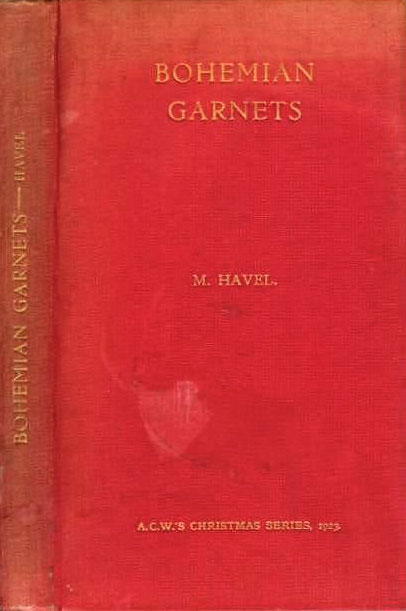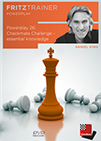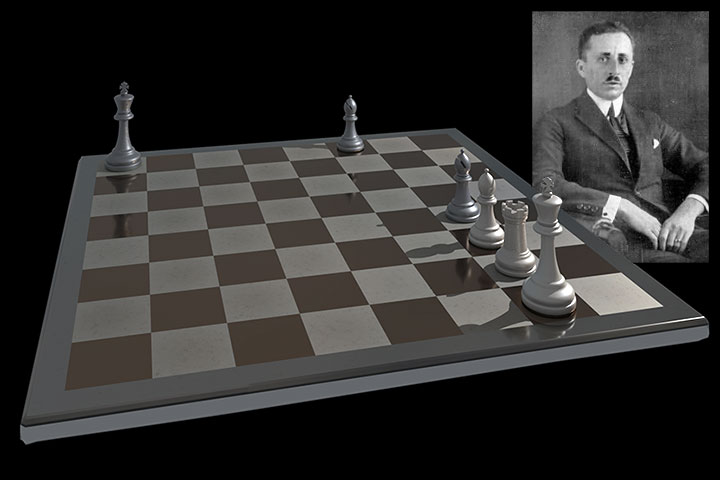Study of the Month: October 2018
2012 was a strange year: With a 5125-year cycle of the Mayan calendar concluding, many people expected the entire world to end (and maybe it did — did you really feel alive since then?). Boris Gelfand challenged Viswanathan Anand in the World Championship and was only defeated in the tie-break. Anna Ushenina won the knockout Women's World Championship in December. Istanbul saw the Chess Olympiad, won by Armenia.
But far away from the “elite” chess, another small sensation happened: 2012 saw a young Bohemian master gaining the title of Grandmaster for Chess Composition: Miroslav Havel. Well, “young” is a relative term as he was born on November 7th, 1881 in Teplice and died on July 8th, 1958 in Prague.
 “Miroslav Havel” was the pseudonym of Dr. Miroslav Košťál. In 1923, Alain C. White dedicated the book “Bohemian Garnets” from the Christmas Series to him, as he was not only known for his endgame studies but also for his “Bohemian” chess problems, or “model mates” (described in detail below). In fact, he is regarded as one of the leading people engaged in that school (which is not a physical school but a school of thought).
“Miroslav Havel” was the pseudonym of Dr. Miroslav Košťál. In 1923, Alain C. White dedicated the book “Bohemian Garnets” from the Christmas Series to him, as he was not only known for his endgame studies but also for his “Bohemian” chess problems, or “model mates” (described in detail below). In fact, he is regarded as one of the leading people engaged in that school (which is not a physical school but a school of thought).
Havel’s beginnings were humble, according to Dedrle in “Bohemian Garnets” moving to Prague in 1884, studying at the High Technical School there later. From 1906 he worked for the “k.k. österreichische Staatsbahnen” (Royal Austrian State Railways), but after the founding of the republic, he was an official for the Czechoslovak Railway-Ministry.
On May 1st, 1898, the first chess problem by Havel was published, he was 16 at that time. (Now, of course, I was 17 when my first study got published, but my springtime as a composer was much shorter, with only a few new ideas nowadays...)
The Bohemian Chess Association (ÚJČŠ — there is no distinction between “Bohemian” and “Czech” in the Czech language.) bestowed the title of “Master of problem chess” in 1947 and “Honored Master of Chess” (of the CSSR) in 1957. Nine years after this first title the newfound Permanent Commission for Chess Composition of the FIDE (PCCC, today independent as the World Federation for Chess Composition, WFCC) gave him the title of International Judge for Chess Composition in 1956, which is earned by applying after judging six international tourneys.
Havel was the president of the Czechoslovakian Association of Chess Composers and Solvers from 1945 to 1950 and the Czechoslovakian organisation for chess composition 1958-1959. Prior and parallel to this, Havel collected experience as the author of the problem section in Československý šach 1927-1933 and Šachové umění 1946-1951 as well as chess columns in Čas 1921-1923, in Národní osvobození 1924-1939 and 1945-48, in Slovenský národ 1925-1926, in Parallèle 50 1951-1952, and finally in the FIDE Revue 1954-1958.
More than 1,900 chess compositions are known from Havel, the first having appeared in 1898. His work consisted mainly of three-movers, i.e. checkmates in three moves, but also more-movers (mates in four or more moves), studies, and others. His 90.33 points in FIDE albums were sufficient for the title of Grandmaster for Chess Composition, which was only invented several years after his death. Each problem selected for the anthology receives one point, split to all authors. Studies receive 1.666... points, so three studies would give five points if composed alone. The title was posthumously given in 2012, as mentioned above. I don’t have all albums, so I can’t say which of his 71 first prize winners, 141 other prizewinners, 143 other honoured compositions, and other works, were selected. However, there are only around 60 known endgame studies of Havel, so he must have gained the majority of his points from threemovers. This, however, means also that the selection for this month is rather a matter of showing his best studies than to make a real editor’s choice.
The master Havel was honoured not only in the abovementioned “Bohemian Garnets” by Alain C. White (1923), but also by I. Mikan in “České granáty 1898-1958” with 1701 Havel compositions (1975).
Like last month, we are grateful to John Beasley for the translation from the Malá encyklopedie šachu, which was our main source, together with the aforementioned Bohemian Garnets. Also, like last month, biographical data is hard to find. Instead we added a small introduction to the Bohemian school, based on our primary source.
A small introduction to the Bohemian problem school
(based on Frantisek Dedrle in Bohemian Garnets 1923)
 First of all, it must be said that the Bohemian school is classified by having three model mates, i.e. checkmates where every white piece except possibly the king and pawn participate and every square around the black king is guarded exactly once by either a white piece or a blocking black piece. “Three“ means that the checkmates are played in three different variations, be it key, threat, or actual play. They do not necessarily have to be different from each other, but at least should be mirrored or rotated. While not strictly necessary, more so than other genres, Bohemian problems often feature lightweight positions with piece play on great parts of the board of White.
First of all, it must be said that the Bohemian school is classified by having three model mates, i.e. checkmates where every white piece except possibly the king and pawn participate and every square around the black king is guarded exactly once by either a white piece or a blocking black piece. “Three“ means that the checkmates are played in three different variations, be it key, threat, or actual play. They do not necessarily have to be different from each other, but at least should be mirrored or rotated. While not strictly necessary, more so than other genres, Bohemian problems often feature lightweight positions with piece play on great parts of the board of White.
As Frantisek Dedrle writes in the introduction to this book, the Bohemian School dates back to the 1860s, coincidentally when chess clubs were first created.
“[T]he chess column began to appear as a regular newspaper feature. Chief among these early columns may be mentioned: Rodinna Kronika, Kvety, Svetozor, Humoristicke Listy, Palecek amd others. They contained for the most part problems and games, with here and there articles on the theory and aesthetics of the problem. It was these articles that laid the foundation of the Bohemian problem school.”
Dedrle goes on to write about the influence of Dr. J. Dobrusky and publications in Svetozor. In 1885 the Zlata Praha became the most important outlet for such compositions. 1887 saw a collection of 321 problems published in a book by J. Pospisil (not to be confused with the study composer Jaroslav Pospisil of today). After two short-lived chess publications, the Ustredni Jednota Ceskoslovenskich Sachistu was founded as the Czechoslovakian chess federation.
Many composers formed the Bohemian school, but possibly the most important one was Miroslav Kostal, or, as he is known in the chess world, Miroslav Havel. Dedrle (see below) characterized the problems as “works of great depth and beauty, and with such marks of a rare talent[, with Havel becoming] speedily acclaimed as a leader who opened up new ways and pointed to new aims.”
Havel rarely used white pawns, but if he did, then in a masterful way. Dedrle praises Havel much on the following pages in Bohemian Garnets. Then he goes onto the role of the white king in a chess problem, which often is only that of a bystander, and even checks against him only serve to avoid duals and ensure correctness. As a counter-example, Dedrle reproduces the “Steinitz Gambit” by Sam Loyd, which has appared numerous times on ChessBase, but is gladly shown once more.
White to move and checkmate in three moves
The king stands safely on f1, yet, just like in the opening the problem was named after, he will leave that safety.
1. Ke2!! f1Q+ 2.Ke3!! (or 1.-f1N+ 2.Rf2+). Black can give no less than ten checks, but all are replied to with a checkmate. 115 years later, this problem still is rightfully famous. Of course, this also might have been the inspiration for even crazier problems that appeared later, but this would go beyond the scope of this article.
Dedrle observes that Havel’s problems often contain echoes, that is, checkmate patterns or even combinations that repeat in other variations on another position on the board, which came about by the exploration of the possibilities of themes. “[Havel] does not use easy, symmetrical positions but produces a symmetrical thought in an asymmetrical form. Note, is it always the model-mate which is echoed: he understands also impure but economical mates: his echoes are produced in strict harmony with rigid economy.” Dedrle sees sacrifices as a veiled un-economy, so he praises Havel for not using them often. In the end, Dedrle writes about Havel’s influence: “That he gave to the Bohemian school this classical style is a reason which by itself makes his work worthy of being studied and criticised with the great earnestness it deserves.”
Three Havel problems
For the convenience of solvers, we give as an illustration to the above words three — not necessarily “Bohemian” (see the definition above) — mate problems by Havel below. The solutions can be found in the replayable board at the end of this article. All of the problems were also taken from the “Bohemian Garnets”, as compiled by George Hume, with the collaboration of Dr. J. Schumer, Alain C. White, Joel Fridlizius, and Otto Wurzburg.
We warn you that they aren’t easy to solve for beginners, but quite possible for experienced solvers. Good luck!
 Checkmate. That's the aim of the game. There are numerous ways to checkmate the enemy king, but there are common patterns that recur over and over again, and having these at our mental fingertips is essential for when we want to finish the game.
Checkmate. That's the aim of the game. There are numerous ways to checkmate the enemy king, but there are common patterns that recur over and over again, and having these at our mental fingertips is essential for when we want to finish the game.
Bohemian Garnets no.4B (page 25)
Bohemian Garnets no.67 (page 150)
Bohemian Garnets no.74C (page 165)
The solutions, as mentioned above, can be found game viewer below. The number in the Bohemian Garnets is also given for reference. The book uses a numbering of the kind 1, 1A, 1B, 1C, 1D for each set of five problems, although they are unconnected. This means, for example, problem 4 is completely unconnected to 4B, so it would make no thematic sense to also reproduce it here.
 The "Mega" is the database every serious chessplayer needs. The database contains 7.1 million games from 1500 to 2017, in highest quality standard, full of top level analyses and completely classified.
The "Mega" is the database every serious chessplayer needs. The database contains 7.1 million games from 1500 to 2017, in highest quality standard, full of top level analyses and completely classified.You probably know that you can move pieces on our replay boards to analyse and even start an engine to help you. You can maximize the replayer, auto-play, flip the board and even change the piece style in the bar below the board.
At the bottom of the notation window on the right there are buttons for editing (delete, promote, cut lines, unannotate, undo, redo) save, play out the position against Fritz and even embed the ChessBase game viewer on your website or blog. Hovering the mouse over any button will show you its function.

World Federation for Chess Composition (www.wfcc.ch)
Links


















 “Miroslav Havel” was the pseudonym of Dr. Miroslav Košťál. In 1923, Alain C. White dedicated the book “Bohemian Garnets” from the Christmas Series to him, as he was not only known for his endgame studies but also for his “Bohemian” chess problems, or “model mates” (described in detail below). In fact, he is regarded as one of the leading people engaged in that school (which is not a physical school but a school of thought).
“Miroslav Havel” was the pseudonym of Dr. Miroslav Košťál. In 1923, Alain C. White dedicated the book “Bohemian Garnets” from the Christmas Series to him, as he was not only known for his endgame studies but also for his “Bohemian” chess problems, or “model mates” (described in detail below). In fact, he is regarded as one of the leading people engaged in that school (which is not a physical school but a school of thought). First of all, it must be said that the Bohemian school is classified by having three model mates, i.e. checkmates where every white piece except possibly the king and pawn participate and every square around the black king is guarded exactly once by either a white piece or a blocking black piece. “Three“ means that the checkmates are played in three different variations, be it key, threat, or actual play. They do not necessarily have to be different from each other, but at least should be mirrored or rotated. While not strictly necessary, more so than other genres, Bohemian problems often feature lightweight positions with piece play on great parts of the board of White.
First of all, it must be said that the Bohemian school is classified by having three model mates, i.e. checkmates where every white piece except possibly the king and pawn participate and every square around the black king is guarded exactly once by either a white piece or a blocking black piece. “Three“ means that the checkmates are played in three different variations, be it key, threat, or actual play. They do not necessarily have to be different from each other, but at least should be mirrored or rotated. While not strictly necessary, more so than other genres, Bohemian problems often feature lightweight positions with piece play on great parts of the board of White.





